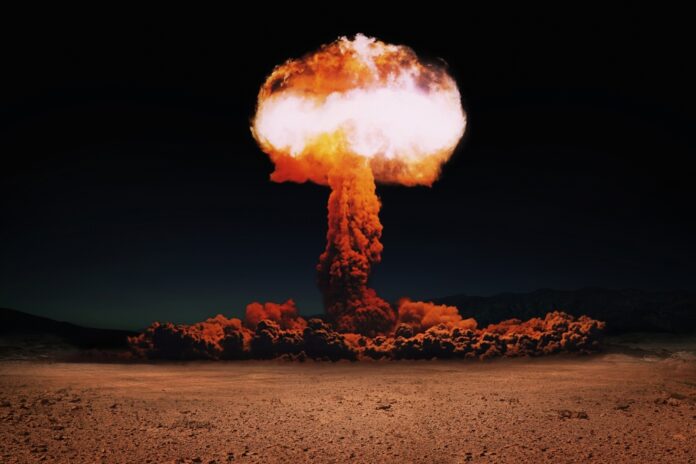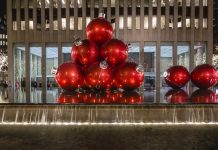One of the newest forms of travel, atomic or nuclear tourism brings visitors to sites associated with nuclear weapons testing, nuclear history, or major accidents. In recent years, this rather niche activity has gained traction, since some past and presently radioactive sites are now accessible to the public.
Las Vegas aka Atomic City
Fascination with these weapons of mass destruction dawned during the 1950s, as the Atomic Age began. The Cold War’s nuclear race was not just a display of power but an opportunity for bolstering national pride and local economies.
Tourism was part of that. Thousands flocked to cities near nuclear testing sites to witness the blinding light of detonations, the earth-shattering booms, and the shock waves. Weapons testing and entertainment went hand in hand.
Nuclear test, Exercise Desert Rock. Photo: U.S. Government
Besides its casinos, Las Vegas soon became known as the Atomic City. Approximately 100km away from the neon lights, in the Nevada Testing Site (NTS), government officials and scientists gathered at a safe distance. They put on special goggles and braced themselves for atomic explosions that equaled several kilotons of TNT.
After one of the first detonations in 1951, residents of Las Vegas and later, the rest of the country, went into an absolute craze. Postcards, music, fashion, and other pop culture signifiers obsessed over the mushroom cloud.
Atomic picnics
Hotels with special viewing rooms began to pop up. People threw atomic picnics with themed food and drink on hills to see the explosions. Las Vegas officials even sent out explosion schedules ahead of time for people to follow.
Detonations took place in the wee hours of the morning. The sky lit up with a blinding flash and the ominous red glow was visible from far-away Montana. Over a 12-year period, one bomb went off every three weeks. In all, 235 bombs were detonated. However, this was atmospheric testing. From 1963, President John F. Kennedy signed the Limited Test Ban. Until 1992, only underground explosion tests were done.
Despite the top-secret testing program, the government often invited the press to witness the detonations closer up. Explosions were televised, most likely as a Cold War propaganda strategy to increase patriotism and rally additional support for the program. However, residents in Nevada and Utah suffered from nuclear fallout and its consequences.
Today, you can tour the craters left behind from the explosions all over the 3,500 sq km testing site. Some craters go 70m deep and over 1,000m wide, reminding tourists of the sheer magnitude of these bombs. You can also see the remnants of the model towns used in the tests, called the Apple-2 houses.
In order to visit, you must be at least 14 years old and supply a lot of personal and professional information that authorities vet ahead of time. It is a government site, after all.
Chernobyl
The greatest cataclysm in nuclear history was the 1986 Chernobyl meltdown. It occurred in Reactor Number 4 after a test went awry on April 26 of that year. After some tragic bureaucratic delays, nearby towns were evacuations and a permanent Exclusion Zone, measuring 2600 sq km, set up.
For years after, the other reactors continued to generate electricity, but the plant has since been abandoned. Nearby towns like Chernobyl, Pripyat, and all the villages within 30km became ghost towns. From 1986 to 2000, over 350,000 people were resettled.
Buildings, schools, hospitals, stores, and homes remain abandoned and derelict. Objects in houses are frozen in time, seemingly waiting for its owners to return.
An abandoned classroom in Pripyat. Photo: Thomasz Jocz/Shutterstock
People from all over the country felt the effects through cancer, autoimmune disorders, and thyroid issues in children. But despite the residual radiation, until last year’s Russian invasion, parts of the Exclusion Zone opened to tourists. (A 2013 book about disaster tourism took Visit Sunny Chernobyl as its title.)
In order to visit, you needed a special permit and a designated tour guide. Because the Exclusion Zone remained in force, you went through a checkpoint. However, you did not need to wear protective equipment, as the marked paths along the tour supposedly had low levels of radiation. You were not allowed to enter any buildings, either. Nowadays, of course, visiting Ukraine itself is more dangerous than any residual radiation from the accident.
Daytimer abandoned in a village near Chernobyl, the days torn away until May 3, 1986, when everyone was abruptly evacuated. Photo: Jerry Kobalenko
Marshall Islands
The beautiful coral atolls of the Marshall Islands were American nuclear testing sites in the post-WWII years. The U.S. government forcibly relocated residents before blowing up the turquoise Pacific waters with around 23 tests until 1958.
As a result, the water, land and people in neighboring islands experienced high levels of radioactive isotopes like strontium-90 and cesium-97. This led to birth defects, premature deaths, stillbirths, miscarriages, cancer and other illness. Bikini Atoll has a relatively sparse population of just a few caretakers and occasionally visiting scientists and divers.
Baker Test in the Marshall Islands. Photo: Everett Collection/Shutterstock
They have been efforts to reclaim Bikini Atoll as a diving and fishing destination. Since it is now deemed safe, divers visit to check out over 23 shipwrecks and a thriving ecosystem (which surprised the scientists).
While some residents have been trying to return to the atoll, they face multiple barriers, including climate change and lack of opportunities and funding to redevelop the islands.
Hiroshima and Nagasaki
On 6 and 9 August, 1945, the United States dropped two atom bombs on Hiroshima and Nagasaki. About 226,000 people, mainly civilians, died. Those who survived suffered terribly in the following years from radiation poisoning, burns, cancer, and brain defects. The cities have since been rebuilt, and include many memorials and museums.
Explosion over Nagasaki. Photo: Everett Collection/Shutterstock
In Hiroshima, tourists visit the Hiroshima Peace Memorial Park to see buildings that withstood the blast. These include the A-Bomb Dome, the Rest House, and many memorials. In Nagasaki, the Nagasaki Peace Park has a similar set up, including remnants of the Urakami Cathedral. Every year, anniversary events commemorate those tragic days.














